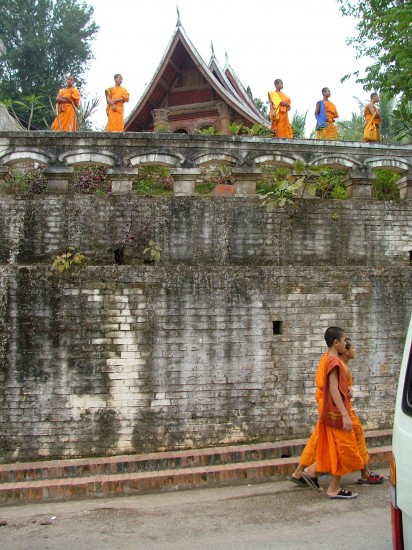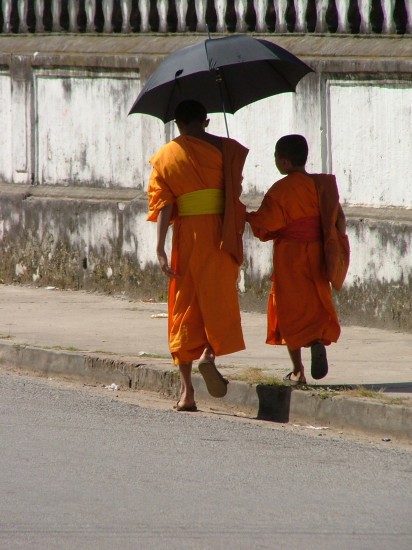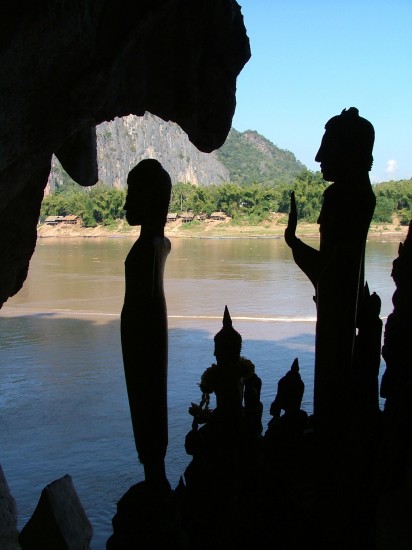In Part 2 of “Journey into Laos,” Vincent Ross discovered the people and spirit of the Mekong River. In Part 3, he comes to Luang Prabang, a stunning UNESCO World Heritage site.
 A long line of silent monks in rich orange robes walk out of the growing light, the swishing of silk and scuffing of leather sandals whispering their approach on the cool, early morning air.
A long line of silent monks in rich orange robes walk out of the growing light, the swishing of silk and scuffing of leather sandals whispering their approach on the cool, early morning air.
The first rays of the sun set aglow the golden spires, the sweeping roofs and gilt-painted, carved timbers of Luang Prabang’s dozens of Buddhist temples and stupas, heralding the start of another day in the former royal capital of Laos.
It was here, on the banks of the Mekong River, in 1353 that King Fa Ngum founded the first Laotian kingdom, Lan Xang (the Kingdom of a Million Elephants).
Luang Prabang was a royal capital off and on for the next 600 years, until the Communist takeover in 1975.
The long line of monks is not a scene from an Indiana Jones film. This is today. This is now, an everyday happening in Luang Prabang that allows visitors to see, breathe and, in some small way, live a piece of its history.
The line of hundreds of shaven-headed monks and novices, old and young, boys and men, stretches back through generations and time.
Carrying begging bowls, they collect alms — handfuls of sticky rice wrapped in banana leaves, coconut milk, vegetables — donated by the local people and, in recent years, by increasing numbers of tourists, to feed them for another day, to fuel their study and devotions to Buddha.
Luang Prabang is a place less ordinary, a cultural lagoon still largely removed from the ebb and flow of modern Asia. It’s not hard to see why the small city, nestled beneath palms around the 100m-high rocky outcrop known as Phu Si on a finger of land between the Mekong and Nam Khan rivers, was called “Land of the Lotus Eaters” in the French colonial era of the late 1800s.
The tag was coloured by the region’s thriving opium trade and the decadent lifestyle of the white-suited colonial officers, more than a few of which consorted with the young women of the town and royal court. A French travelogue written in 1909 described Luang Prabang as “in reality a love, a dream, a poetry of naive sensuality which unfolds under the foliage of this perfumed forest”.
Today, things are a little less exotic, a lot less erotic. Town life carries on around, and mostly despite, the tourists. The local Laotians are friendly, polite, but not intrusive.
Luang Prabang lacks the frenetic pace of many Asian tourist spots.
UNESCO added it to the World Heritage list in 1995, claiming it “the best preserved city in South-East Asia”. About 50,000 people, including around 400 monks and novices, live in and around Luang Prabang, which has largely escaped the tide of war which has swept back and forth across northern Laos over the centuries.
UNESCO staff oversee the restoration and preservation of more than 30 temples (known as wats), chapels and pavilions and more than 100 Laotian-French buildings.
It is a balancing act for UNESCO in the face of a rising middle class which increasingly looks towards the trappings of modern Asia.
Please bookmark Life As a Human and come back tomorrow night at 9 pm PST for Part 4 of Vincent Ross’ “Journey into Laos”.
Photo Credits
“Laos: Luang Prabang Buddhist monks at the monastery” © Vincent Ross. All Rights Reserved.
“Laos: Luang Prabang youn g monks on the way to the monastery” © Vincent Ross. All Rights Reserved.
“Laos: Pak Ou Caves near Luang Prabang” © Vincent Ross. All Rights Reserved.




[…] Part 3 of Journey into Laos, Vincent Ross travelled along the Mekong River to Luang Prabang, a place of […]